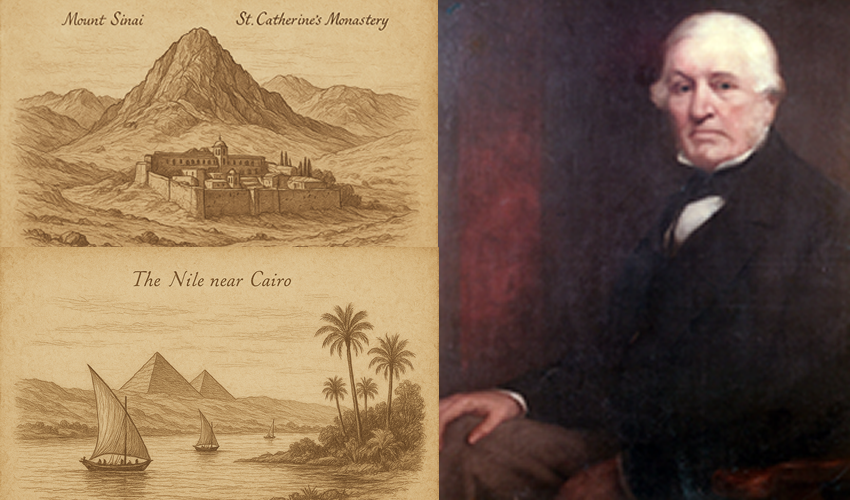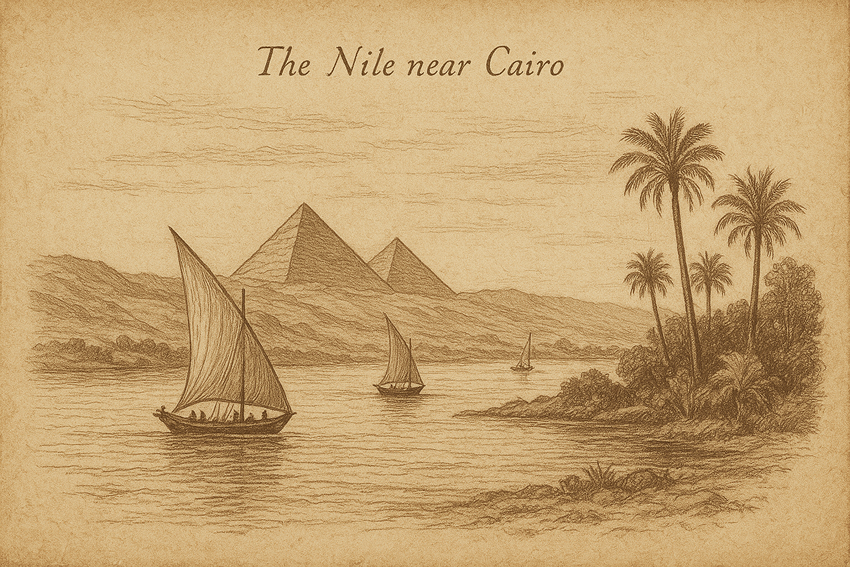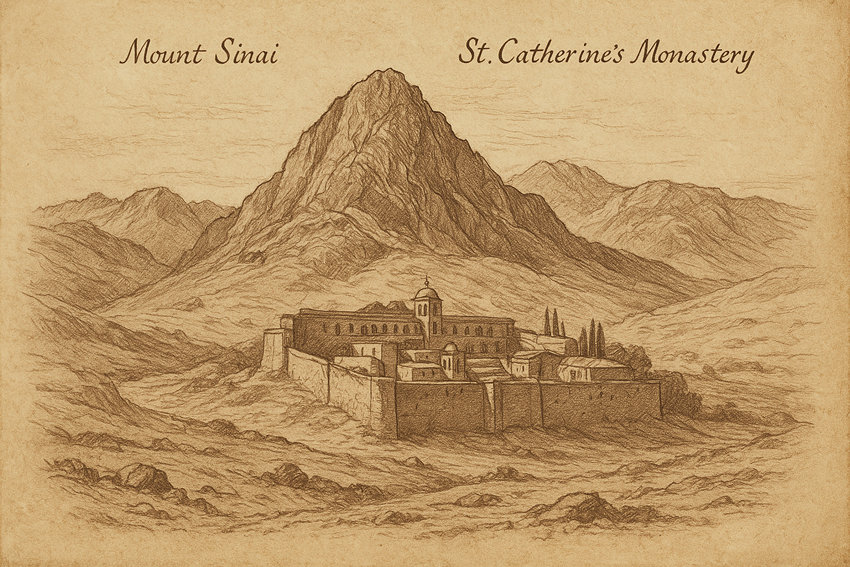Robert Tassell Sr, the builder of Cobdown House, was an interesting character who faced considerable hardships when travelling to the Victorian Holy Lands
This is summary of the letters of Robert Tassell to his daughter Mary and the Travel Journal of his son, Robert Tassell Jnr during travels to Egypt and the Holy Lands of the Middle East seen through the eyes and observations of travellers of this era. (Summarised from Letters and Journals held at Middle East Centre, St Antony’s College, University of Oxford)
In an age when European exploration of the Middle East was still an enterprise of courage and curiosity, Robert Tassell, and his son Robert Tassell Jnr, a solicitor of the Inner Temple, embarked on an extraordinary expedition through Egypt, Nubia, the Sinai Desert, Arabia Petraea, Palestine, and Syria, culminating back in Constantinople. Their story, preserved in a series of letters and his son’s detailed travel journal, offers a rare window into early Victorian travel — a blend of faith, endurance, and their fascination with the old Biblical world reveals the vast diversity of the Middle Eastern world on the eve of modern change.
Robert Tassell Snr., writing in affectionate letters to his daughter Mary, chronicles the journey with a father’s warmth and a scholar’s curiosity. His son, meanwhile, keeps a detailed journal — part travelogue, part archaeological diary — offering sharper descriptions of landscapes and people.
Setting Out: From England to the Banks of the Nile
The adventure began on 30 October 1839, when the father and son departed England, bound for Malta and Alexandria. Their voyage was beset by storms and seasickness yet buoyed by excitement at the travels to come.
Upon arrival in Egypt, Tassell wrote home in astonishment: “The glare, the camels, the confusion — a world wholly unlike our own.” Cairo proved both magnificent and miserable, with dazzling mosques and the eternal pyramids standing in contrast to slavery, plague, and poverty. The pair ascended the Pyramids of Giza, sailed the Nile among feluccas, and marvelled at the meeting of antiquity and the tyranny under the then viceroy Mehmet Ali.
Through ‘Sand and Stone’: The Sinai and Arabia Petraea
In January 1840, accompanied by Mr Formby, a fellow Englishman, and an entourage of Arab guides, Maltese servants, and Egyptian camel-drivers, the Tassells struck eastward across the Sinai Desert.
Nights were cold, food scarce, and tempers short. Robert Jnr’s diary records: “Our servants, though cheerful, are drunk whenever opportunity allows.” Still, hardship turned to reverence at Mount Sinai, where they visited St Catherine’s Monastery where they were welcomed by Greek monks who shared bread, coffee, and scripture. The younger Tassell’s sketchbook records the austere fortress and the jagged peak said to be where Moses received the Law. climbing the sacred summit by dawn. “I felt the Almighty nearer here than ever before,” and observed “Scripture and stone breathe together.” wrote Tassell Snr to his daughter.
Into the Holy Land: ‘Faith and Famine’
Crossing Arabia Petraea, they reached Petra, whose rose-red ruins they described as “the silent witness of a perished grandeur.” Entering Palestine via Hebron, they came at last to Jerusalem — “a city of holiness and decay.”
Tassell Snr attended services at the Church of the Holy Sepulchre, while his son joined Protestant missionaries such as Mr Nicolayson and Rev. Grimshawe, where in Tassell Jnr’s journals the tension between rival Christian sects was noted and Snr wrote movingly of Palm Sunday processions at the Church of the Holy Sepulchre, where rival Christian sects jostled for ritual precedence.
During the Easter season, the pair joined Ottoman-escorted pilgrims bathing in the River Jordan and exploring the Dead Sea, whose waters Tassell described as “a basin of lifeless calm — dreadful yet divine.” Their tents swarmed with fleas, and plague loomed over nearby villages, forcing detours through Samaria, Sebaste, and Nazareth.
Perils and Plagues on the Road
The journey northward brought both wonder and danger. They visited Mar Saba Monastery, ‘clinging like a swallow’s nest to the cliffs of the Kidron Valley’, before pressing on through Samaria to Nazareth. There they encountered plague and were forced to sleep outside village walls, guarded by Arab grooms known as seys.
Fleas, famine, and fever stalked their caravan; supplies ran short, and water was fouled. Yet Tassell Sr wrote to Mary, “If the body is weary, the soul is ever fed by the vision of sacred ground.”
Northward to Lebanon: Palaces and Politics
By May 1840, the travellers had reached Tyre, Sidon, and finally Beirut, finding beauty and bustle on the Phoenician coast. Here, fate introduced them to Mr Briggs, an English acquaintance who arranged a rare audience with Emir Beshir II Shihab, ruler of Mount Lebanon.
At Beiteddine Palace, the Tassells were received in oriental splendour. The Emir’s ‘Circassian wife’ and courtiers entertained them amid mosaics and fountains — “a scene of Arabian Nights magnificence,” Robert Jnr recorded. Yet beneath the splendour, Lebanon was simmering with sectarian tension, which the elder Tassell read as “a symptom of Ottoman decay.”
The Final Stage: Constantinople and Homeward Bound
Illness and exhaustion marked the final leg of their journey. Abandoning plans to visit Baalbek and Damascus due to plague, they sailed north to Constantinople. There, amidst the domes and minarets of the Ottoman capital, Tassell reflected on the sweep of empire and faith. “We have traversed the lands of Abraham, Moses, and Christ — and returned richer in gratitude than in gold,” he concluded in his last letter home, dated July 1840.
They sailed westward via the Aegean and Malta, returning safely to England after nine months of peril, prayer, and discovery.
The journey spanned nearly nine months and thousands of miles. They faced storms, thirst, disease, and deceitful guides, yet both father and son wrote with gratitude for their deliverance.
Their writings reveal a tension familiar to many Victorian travellers — admiration for the East’s splendour, tempered by the prejudices of empire. Hardship was constant — fleas, famine, and fever — yet the travellers’ resilience and faith carried them through.
Legacy of the Journey
Today, their letters and journals — preserved at St Antony’s College, Oxford — offer a rich window into the Middle East before photography, railways, and colonial transformation. Their observations of Mehmet Ali’s Egypt, the Ottoman frontier, and the enduring vitality of local life make the Tassell Expedition one of the most evocative British journeys of its time.
As the elder Tassell wrote upon his return:
“I left England with curiosity, I return with reverence; for no man can tread those sands and not feel the ages beneath his feet.”
Images are based on descriptions and the style of sketches of the time and are not part of the Journal and letters.




